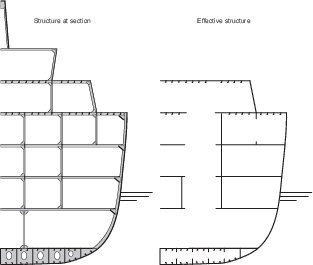
Section
6 Global loads

6.1 General
6.1.1 For the whipping WH, residual strength RSA and Extreme strength ESA notations, there are distinct levels and types of threat
that can be defined. The size and type of threat has no influence
on the survey requirements.
6.1.2 All three
notations have a different method for determining the load as they
all deal with different events, however, once that load is defined,
the structural assessment method and acceptance criteria are common
to all three.
6.1.3 There are
different methods of assessment which are identified by the last figure
of the notation. The more complex methods denoted by WH2, WH3, RSA2, RSA3, ESA2 and ESA3, use different acceptance criteria and this will lead
to different survey requirements.
6.1.4 For all three
notations, the effect concerns the global capability of the ship girder
and maintaining capability is similar to maintaining the longitudinal
strength of the ship for normal sea loads.
6.1.5 Thus, changes
to the effective sectional inertia in the midship region where the
loads are highest, are most critical.
6.1.6 For each of
the notations it is important to establish the effective and non-effective
structure. For the simple methods of assessment, denoted by WH1, RSA1, and ESA1 the definition of such structure
is given in Vol 1, Pt 6, Ch 4, 1.4 Calculation of hull section modulus of
the Rules for Naval Ships. For the more complex methods of assessment,
denoted by WH2, WH3, RSA2, RSA3, ESA2 and ESA3 the definition of
such structure is given in Vol 1, Pt 6, Ch 4, 1.4 Calculation of hull section modulus of the Rules for Naval Ships. An example of the
typical amount of structure at a section and that which is effective
is given in Figure 16.6.1 Effective structure for a typical ship section. The structure
deleted can be considered non-effective as it does not contribute
to global longitudinal strength.

Figure 16.6.1 Effective structure for a typical ship section
6.1.7 Where the
structure is found to be outside the limits defined in this Section,
the condition should be reported to the LR Naval liaison office.

6.2 Corrosion
6.2.1 For the simple
methods of assessment, denoted by WH1, RSA1,
and ESA1 the allowances for corrosion and degradation
of plating and secondary structure can be the same as for a normal
ship structure.
6.2.2 For the more
complex methods of assessment, denoted by WH2, WH3, RSA2, RSA3, ESA2 and ESA3,
to maintain the capability of a ship structure, the local allowances
for corrosion and degradation of structure can be the same as for
a normal ship structure, see
Ch 10 Corrosion.
However, there should be a negligible reduction (less than 0,5%) in
the top side and bottom areas of the section of effective material.

6.3 Alignment and tolerance
6.3.1 For the more
complex assessment method, denoted by WH2, WH3, RSA2, RSA3, ESA2 and ESA3,
it is essential that the alignment and tolerances are in accordance
with the design assumptions. In most cases these should be in line
with the normal requirements of Ch 3 Construction Procedures. If
tighter tolerances are required, then they should be indicated on
the approved plan.

6.4 Modifications
6.4.1 For all three
threat types and methods of assessment, the capability of the structure
is dependent on the amount of material in the section. Any removal,
of structure for hatches, doorways, trunking, shipping routes anywhere
along the length could reduce the amount of effective material and
hence the capability of the ship. The most critical sections are those
within 0,3L
R to 0,7L
R or
where the section inertia is at a minimum in way of large openings
for lifts and uptakes or downtakes. The assessment of capability is
normally made at these critical sections.
6.4.2 It is also
important to note that openings have a 30° shadow area associated
with them as defined in Vol 1, Pt 6, Ch 4, 1.5 General of the Rules for Naval Ships, and this should be taken
into account when calculating the amount of effective material at
the section under consideration.
6.4.3 The buckling
capability of longitudinal structural members is important for the
strength of the section. Changes that may affect the buckling capability
are:
- Misalignment of primary structural members.
- Increases in the effective length of members by the removal of
minor structure.
- Distortion of members outside the allowable tolerances during
fabrication or due to repairs.
- Severing longitudinal structure by modifications without adequate
reinforcement.
6.4.4 For the more
complex methods of assessment, denoted by WH2, WH3, RSA2, RSA3, ESA2 and ESA3,
the capability of a ship structure is also sensitive to the local
geometry, in particular hard corners. These are formed when primary
structure such as decks and bulkheads intersect. Longitudinal minor
bulkheads, which for longitudinal strength purposes are considered
ineffective, will, under the more complex assessment methods contribute
to the strength of the section if they span between main watertight
bulkheads.
|